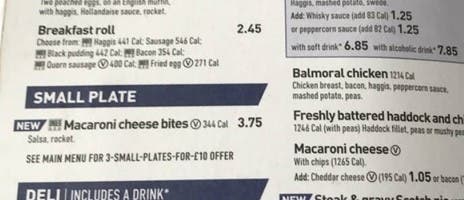THE war on numbers has begun. Or rather the battle of the bulge. As you will no doubt have heard, UK restaurants with over 250 employees have been displaying the calorific content of the dishes on their menus since April 2022 in a bid to persuade the British public to order food healthily.

In a label-conscious society we’ve been fed on a diet of brands and logos since the 1980s and now our brains will be dissecting even more data from our dining companions as they navigate the calorie labels in many of the popular UK high street restaurant chains.
The measures come on the back of soaring obesity rates, partly accelerated by the Covid-19 pandemic. The British government states that “overweight and obesity related conditions across the UK cost the NHS £6.1 billion each year. Almost two-thirds (63%) of adults in England are overweight or living with obesity – and one in three children leave primary school overweight or obese.”
Not everyone is happy with the UK Government’s bid to persuade us to be more calorie conscious and many experts who work with disordered eaters have raised some well-founded concerns.
According to Katie Schmidt, a qualified and highly-seasoned Behavioural Food Therapist who has lived in Switzerland and Spain for a number of years calorie labelling is “not enough to support sustained behavior change. And for the thousands of eaters who have an anxious, reactive, or disordered relationship to food, calorie counting on menus can backfire and trigger further restrictive eating patterns or binge eating episodes. Schmidt has seen first-hand with clients that a transformation in how we relate to food and the choices we make is key to fostering healthy eating habits as “Calorie counting keeps us disconnected and in distrust of ourselves and our bodies.”
The average Spanish waistline is also expanding due to the prevalence of home working and a more sedentary lifestyle but what is particularly alarming is the fact that Spanish children aged 5-10 years old are now in 4th place in the European obesity charts after Greece, Malta and Italy. (Source: World Obesity Federation)

In Spain, children’s eating habits have altered noticeably since my husband´s meagre merienda consisted of 4 cm of freshly-baked baguette stuffed with 3 wafer-thin slices of chorizo. Nowadays “bollería industrial”, those long-life highly-processed sugary buns, prevail on most breakfast tables as well as in the backpacks of school children to be consumed mid-morning as well as after school snacks.
Much to my chagrin, nutritious food was always a priority in my family and whilst my friends were crunching hula hoops off their fingers in school breaks, I was buzzing round the playground on a sugar high thanks to the two orange dextrosol energy tablets my health-conscious mother popped in my satchel every day.
I’m surprised the Spanish have room for snacking as they’re one of the few cultures to advocate tucking into a meal seconds before that meal is even served; namely the prolonged pre- prandial aperitivo at lunch or dinner. The British concept of an aperitif is to open up the appetite with a few salty KP nuts and Golden Wonder crisps, not to fill it up to bursting with half an acorn-fed cured pig. When invited to someone’s home I sometimes find that the main act is somewhat disappointing after a few plate-loads of jamón ibérico and crispy croquetas to start.
Can you imagine what calorie labelling might look like in the average tapas bar menu of croquetas, gambas al ajillo and chorizo en sidra. The bar would have to increase the width of the menu to squeeze all those noughts in and Tapas Tuesday would be reduced to a guilt-ridden exercise in self-control.
Personally, I think we should be focussing on nutrition not calorific content as 200 calories of chocolate is not metabolised the same way as 200 calories of carrot sticks and hummus. Doesn’t taste the same either for that matter. Still, I have to confess that I assumed that calorie labelling was superfluous to someone who prides herself on being something of a foodie. However, a cursory glance at some well-known websites of chain restaurants on the UK high street proved me quite wrong.

Take Carluccio’s with zillions of branches from Beverley to Bristol: the Vegan breakfast of sourdough, avocado with vegetables and sautéed potatoes comes in at a whopping 818 calories compared to their Eggs Benedict of roast ham, 2 poached eggs with hollandaise on toasted ciabatta with only 544. Even a breadcrumbed Chicken Milanese equates to 685 calories versus a pan-fried fillet of Seabass with tomatoes, white wine and fennel at 826. I feel that these labels are misleading and do not take into account the nutritional value of the ingredients.
One person who won’t be counting the calories on June 5 is Her Majesty the Queen. According to the BBC, a Lemon Swiss Roll and Amaretti Trifle has won Fortnum & Mason´s Platinum Pudding competition. I have to say the recipe title is somewhat misleading as it takes an awful lot longer than a trifle to make it. In fact, you can forget rolling this one out in a lemon jiffy as the crowned Jubilee Pudding takes a protracted two hours to concoct. And with a sugar-charged list of ingredients such as jelly, lemon curd, custard and chocolate bark you had better enjoy it in a small independent café that is exempt from listing its calorie content.

About Susannah Grant
Now on her fourth residency in Madrid, London-born Susannah has seen the city flourish since the 1980s. In retaliation to countless family holidays in the frozen wilds of Northern Scotland Susannah has been making up for lost time (and sun) travelling to over 86 countries. A wordsmith at heart, she is fluent in 5 languages and fascinated by people and cultural idiosyncrasies the world over. Following a 12 year-marketing career in the wine and spirit industry she now devotes her time to writing and editing.

